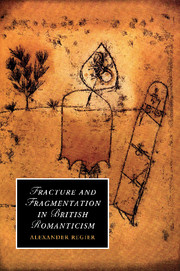Book contents
- Frontmatter
- Contents
- Acknowledgements
- List of abbreviations
- Broken origins: an introduction
- 1 A brotherhood is broken: Babel and the fragmentation of language
- 2 Figuring it out: the origin of language and anthropomorphism
- 3 Forces trembling underneath: the Lisbon earthquake and the sublime
- 4 A blue chasm: Wordsworth's The Prelude and the figure of parenthesis
- 5 Letters from the grave: John Keats's fragmented corpus
- 6 The doubling force of citation: De Quincey's Wordsworthian archive
- 7 Philological fractures: Paul de Man's Romantic rhetoric
- Notes
- Bibliography
- Index
- CAMBRIDGE STUDIES IN ROMANTICISM
Broken origins: an introduction
Published online by Cambridge University Press: 06 July 2010
- Frontmatter
- Contents
- Acknowledgements
- List of abbreviations
- Broken origins: an introduction
- 1 A brotherhood is broken: Babel and the fragmentation of language
- 2 Figuring it out: the origin of language and anthropomorphism
- 3 Forces trembling underneath: the Lisbon earthquake and the sublime
- 4 A blue chasm: Wordsworth's The Prelude and the figure of parenthesis
- 5 Letters from the grave: John Keats's fragmented corpus
- 6 The doubling force of citation: De Quincey's Wordsworthian archive
- 7 Philological fractures: Paul de Man's Romantic rhetoric
- Notes
- Bibliography
- Index
- CAMBRIDGE STUDIES IN ROMANTICISM
Summary
To fill a Gap
Insert the Thing that caused it –
Block it up
With Other – and 'twill yawn the more –
You cannot solder an Abyss
With Air –
How do we fill gaps? Why do we want to fill them? What is the nature of fracture and fragmentation, in contrast to wholeness and plenitude, and our fascination with them? How can we get a grasp on our intrigue with the conceptual, historical, and material fissures that we use to account for ourselves? Emily Dickinson's concentrated lines, written in 1863, broach these questions of fracture and fragmentation effectively. Her poem thematises how an anxious desire to fill a ‘Gap’ only leads to replacing the fracture with its origin, which is ‘the Thing that caused it’. Any attempt to ‘Block it up’ with another substance results in the gap ‘yawn[ing] the more’. But whatever caused the fracture to begin with must repeat this break. To ‘insert’ the cause of a ‘Gap’ is endlessly to reproduce the fracture. The impossibility of ‘filling’ this gap either with itself or with emptiness – with ‘air’ – leaves the fracture unrepaired at the centre of the poem. The ‘Gap’ turns into an ‘Abyss’ that cannot be soldered, marked by the parenthesis and incompleted punctuation in the poem. The origin of our means to solder turns out to be broken.
- Type
- Chapter
- Information
- Fracture and Fragmentation in British Romanticism , pp. 1 - 29Publisher: Cambridge University PressPrint publication year: 2010

